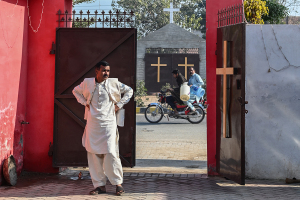Researchers Uncover 4th Century Coptic Christian Community in Egypt
A team of Egyptian researchers has saved an ancient Christian settlement from disappearing in the sands of time.
The English edition of Egypt's Almasry Alyoum newspaper reported that diggers discovered a 4th century Coptic community in the nation's Ain al-Sabil region last week. Located by Egypt's Supreme Council of Antiquities, the rare find joins such historical Egyptian sites as the Pyramids, the Sphinx and King Tut's tomb.
"We never had an excavation in Ain al-Sabil before," Mostafa Amin, the council's Secretary General, told Almasry Alyoum. "Maybe we'll find other antiquities that would add to Egypt's archeological treasures."
Mohsen Ali, the council's director of Islamic and Coptic antiquities, said researchers found a large house with living areas, a central hall, and a working kitchen with an oven and a staircase. Bronze coins and clay pottery were also unearthed, and the site's main discovery is a basilica church surrounded by living arrangements likely for priests.
Sean McLachlan of AOL's Gadling travel blog reported that the find is the latest concerning Egypt's early Coptic Church. The denomination was founded shortly after Christ's crucifixion when St. Mark visited the Middle East and preached in Egypt. Since then, the church has alternatively thrived and suffered depending on interactions with its Muslim neighbors.
"Copts have faced discrimination and deadly attacks ever since the Muslim conquest of Egypt in the seventh century A.D.," McLachlan said. "Periods of tolerance have alternated with periods of increased persecution. In recent years there have been many attacks against Egypt's Coptic community, and Copts say the authorities have done little to help."
"The fourth century A.D., on the other hand, was a high point in Coptic history," he continued. "The majority of Egyptians were Christian at that time and Egyptian monasteries started the Christian monastic movement."
McLachlan said that Egypt's Copts continue practicing their faith today despite their status as a religious minority there. He estimated that 10 percent of the Egyptian population is Copts, or about eight million people. An additional four million practice Coptic Christianity overseas, he said, and a half-million more are located in Sudan.
Coptic.net, a leading online resource for Copts, said that the Coptic Church is renowned for its role as one of Christianity's earliest church bodies. The church affirms the Nicene Creed and gave rise to the tradition of Christian monasticism elsewhere in the world. Perhaps most importantly, it added, the Coptic Church has helped Christianity maintain roots to its earliest days by producing extensive documentation of the Gospels.
"Although fully integrated into the modern Egyptian nation, the Copts have survived as a strong religious entity that prides themselves on their contribution to the Christian world," Coptic.net said. "Daily, in all Coptic churches all over the world, Copts pray for the reunion of all Christian churches."
Egypt's Supreme Council of Antiquities Secretary General Mostafa Amin said that the Ain al-Sabin region could contain additional secrets as his group's discovery of the Coptic community occurred during their first search there. In a column written last month for the Council of Supreme Antiquities' website, he said that Egypt's historical record continues evolving as new artifacts surfaces.
"I have always believed that we have unearthed only about 30% of our monuments and that 70% still lies buried beneath the sand," Amin wrote. "This, of course, means that there will always be news of new discoveries in Egypt, and that was certainly true this month."





























